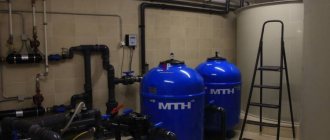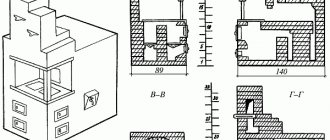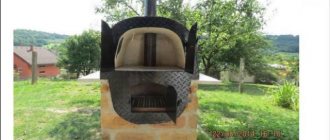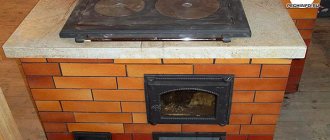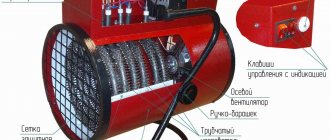In the absence of the necessary supply of firewood at a summer cottage, which is often subject to power outages, the house can be heated using a stove running on diesel fuel or other liquid fuel.
This device does an excellent job of heating those rooms where there is good air ventilation. The back wall of the miracle stove is equipped with a fuel tank into which diesel is poured. The most common types of fuel for such a stove are kerosene and diesel fuel. The first type of fuel is considered more environmentally friendly and economical. When it burns, less harmful gases are released into the environment. At the same time, the efficiency of kerosene is 20% higher than that of diesel fuel.
All models running on diesel fuel differ in power, indicated in the range of 1.8-5 kW. If the fuel tank is topped up, the stove will operate for 18 hours. Nevertheless, the operating time of the unit is determined by the capabilities of a particular model.
Technical characteristics and operating principle of the “Miracle” stove
An electric oven looks like a deep frying pan with massive walls, made of silumin or aluminum alloys. The standard volume varies between 2.0-5.0 liters. The design of the furnace includes two main components:
- working container into which products are placed;
- cover - a thermoelectric heating element is built into it.
The factory set includes metal molds intended for baking confectionery products, a stand on which it is convenient to place a hot oven (it is with its help that you can leave the appliance working on the table). The key feature of the model in question is that the heating element is located in the lid. The manufacturer offers three modifications of “Miracle” stoves with a volume of 2, 3.5 and 5 liters, respectively, their power is 500, 800, 1000 W. In modified modern variations, a sight glass is inserted into the lid.
When using such an oven, the products are heated from above; they do not come into contact with the hot surface, unlike cooking in a conventional frying pan. Therefore, food heats up slowly and evenly and never burns.
Technical data of the most common modification of 3.5 liters:
- diameter – 28 cm,
- depth – 7 cm,
- power up to 800 W,
- power supply from a standard 220 V network.
This model is actively used for preparing a wide range of main courses, which may include fish, meat, and vegetables. This miniature oven produces very tasty, fluffy baked goods - confectionery products, bread. The electric device is useful in a country house, in the country; it attracts with its versatility. The most successful applications:
- as an electric frying pan with top heating to produce baked goods, main dishes and liquid dishes;
- in the form of a familiar electric stove - the lid will be responsible for this function. The stove is connected to the network, a kettle or saucepan is placed on the closed lid;
- as a universal kitchen unit - food is placed inside, and a container is placed on top for preparing another dish.
In the latter case, rational energy consumption is ensured.
Types of autonomous diesel fuel heaters
To begin with, we list all the types of heating devices that use liquid fuel and are most often used by users:
- mini-ovens “Solyarogaz” with a power of 1.8-5 kW from the Russian brand Savo and their analogues;
- various diesel fuel heaters with forced air supply, also known as heat guns;
- a simple direct combustion stove for a garage is one of the most popular home-made designs;
- stove - dropper.
Now we will consider the heating units separately and identify all the positive and negative aspects of their operation.
Review of the miracle diesel stove from Savo
Where such a catchy name came from is unknown. Most likely, it was invented by marketers promoting this product on the market. In fact, the miracle stove, powered by diesel fuel and kerosene, is a modernized descendant of kerosene gas, which was used during Soviet times for cooking. The operating principle is as follows:
- After opening the control valve, the fuel from the tank independently flows into the bowl, where the ends of two fabric wicks are immersed.
- Then the law of capillary rise of liquid operates, due to which the wicks wound on the burner are thoroughly saturated with diesel fuel.
- 2-3 minutes after impregnation, the burner is ignited with matches or a lighter. The operating mode is reached within 10 minutes.
- To turn off the diesel burner, you must close the fuel valve. The heating stove will completely go out in 6-10 minutes, when the diesel fuel that has soaked the wicks burns out.
Heating devices "Solyarogaz" (Ukrainian equivalent - "Motor Sich") can boast the following real advantages:
- Acceptable price. Mini-stove PO-1.8 (power 1.8 kW) retail costs about 37 USD. e., and the price of a 5-kilowatt heater is 95 USD. e.
- Mobility due to small dimensions and low weight. The weight of the same 1.8 kW diesel-kerosene heating stove is 5.6 kg.
- Economical. If you believe the passport, then miracle diesel stoves with a heat output of 1.8-2.5 kW consume about 200 ml of diesel fuel in 1 hour. Judging by the reviews, real fuel consumption is practically no different from the rated one.
- Again, judging by user reviews (read in the next section), the stove does an excellent job of heating small rooms, even poorly insulated ones.
- The product is intended not only for heating, but also for cooking (a steel mesh is installed above the burner).
Let's move on to a few fly in the ointment. The first is inertia, which manifests itself during ignition, shutdown and adjustment of combustion intensity. As noted above, warming up and extinguishing the burner takes 6-10 minutes, and a change in the flame is observed 20-35 seconds after turning the tap, so you need to get used to the stove.
The second important disadvantage of a diesel miracle stove is the release of combustion products directly into the room. Hence the requirement for instructions on organizing supply and exhaust ventilation in a heated room. The minimum amount of exhaust and supply air is stated at 20 m³/h. Natural ventilation will provide this much, provided that the hood works well.
The next disadvantage of mini-stoves using diesel fuel stems from the previous one. The fact is that the existing ventilation carries some of the generated heat outside, which reduces the efficiency of the heater. True, for a dacha or garage this nuance does not play a big role, unlike residential premises. And the last point: the unit emits acrid smoke when igniting and extinguishing, so it is better to perform these operations outdoors.
Advantages and disadvantages
Advantages of the model under consideration:
- versatility. This closed household appliance allows you to fry, bake, stew foods;
- lack of burdensome care. Food does not burn or stick to the walls, so cleaning this pan is very easy;
- presence of a heating function. The device can replace a microwave oven;
- ergonomics and reliability. The shape of the unit is very convenient to use and maintain; it is important that it does not contain such frequently broken modules as indicators and backlighting, auto-shutdown, etc.;
- uniform heat distribution. This effect is achieved thanks to the special design of the thick-walled housing;
- compactness. The unit takes up minimal space.
What does the “Miracle” electric oven look like?
The disadvantage of traditional domestic variations is the lack of buttons that allow you to adjust the temperature, as well as a shutdown timer, which would make the cooking process more convenient. But in analogues of the usual Soviet models, these imperfections are eliminated.
Device
- Removable fuel mixture container. The container has a valve.
- Wick and part of the block.
- Frame.
- Burner.
- Screw for adjustment.
- Lattice.
- Reflector.
A reflector made of metal material is mounted on a body that is painted with a powder-type paint. Due to this element, the house is heated most well.
You might like the article about the Sudarushka stove with a cast iron firebox. You can read about fuel consumption in a pellet boiler here. You may also find this article about the potbelly stove POV-57 useful.
The burner itself is installed in the central part of the device, and diesel fuel is supplied independently from the fuel tank, which is installed on the rear panel. The adjustment screw is necessary to set the appropriate temperature when heating the house. All stoves are made of material that is resistant to high temperatures.
Features of operation
The package usually includes:
- deep frying pan,
- cover with built-in heating element,
- stand,
- molds for baking bakery and confectionery products,
- power cord.
The principle of operation of the device is based on the fact that heat coming from above is evenly distributed throughout the useful volume. The power of the heating elements is sufficient to use the device as an electric stove.
According to the attached instructions, before first use the unit must be washed and dried thoroughly (the product must be removed from moisture manually after each wash). To avoid burns, do not touch the oven while it is on with bare hands; it must not be used with a damaged cord. To maintain the non-stick coating, you should use silicone and wooden spatulas, and refrain from using abrasive cleaners.
The manufacturer recommends first installing the unit on the stand, plugging it in and leaving it for 10-15 minutes to warm up the lid. In this case, the products placed further will cook much faster and retain their taste. After the ingredients are loaded into the bowl, close the lid and bring the dish to readiness.
Do not place the stove on a melting surface
To increase the service life of the device, you must strictly follow the maintenance, operation and safety rules specified in the instructions. To prevent corrosion, the product must be stored dry. Prohibited:
- place a hot stove on a fire or melting surface;
- lift the cover holding the plug socket;
- repair the unit while it is on;
- immerse the entire device in water or wash under running water;
- leave the oven in active mode unattended;
- leave it on for a long time without food;
- touch metal parts of the device while using it.
There are frying pans with a corrugated or smooth surface. The latter are optimal for stewing, baking, boiling; the grooved models are convenient for grilling chicken and frying foods. A separate category of devices is equipped with devices that replace the usual double boiler. The most common are round frying pans, but if desired, you can find series of square and elongated shapes.
The more powerful the device, the faster the food is cooked in it, and the more intense the heat treatment occurs. When choosing the most convenient oven, you should focus on the material from which it is made, the convenience of the control panel, the specific design of the lid, the diameter and volume of the frying pan.
Drip stove
It is well suited for small spaces and is easy and quick to make. This is an ideal device for heating a camping tent and small structures. Here is the step-by-step process of creating a heater with your own hands:
- are determined with the object for which the device is created. For a small room 3*3 m you will need a box 30*30*45 cm;
- depending on the size of the stove, you can take a fire extinguisher and saw off the bottom, or a 200-liter tank (for a large appliance). These elements serve as the cabin of the heating vehicle;
- For diesel fuel you will need a 2 liter medical burner. A small-diameter copper tube 1 m long is connected to the rubber hose with which it is equipped; it must be bent at a right angle;
- the hose is bent in half, a clamp is fixed at the bend to secure the stove elements. The screw is installed so that the liquid drips slowly;
- A rag is placed inside - this is a wick. It is saturated with diesel fuel; a good material for it would be cotton briquettes from an old mattress;
- the door is installed;
- in the body in the center or near the door itself, but not near the pipe, a hole is drilled to fit the diameter of the copper tube;
- the rag is set on fire, fuel slowly drips onto it - this is how this stove works.
Review of modern analogues
In addition to traditional variations, the production of which was established 30-40 years ago, you can find improved models - more ergonomic and lighter, equipped with a number of additional functions.
Sakura SA-7704
Here the lid is made of tempered glass, and the bowl has a non-stick layer. The thermostat allows you to set the optimal temperature. The power of the device is 1300 W, the frying pan is quite deep - the height of the walls reaches 9 cm, the diameter is 32 cm.
Clatronic PP-3411
The model is convenient for stewing, boiling, heating food, frying, as it has a durable non-stick coating. The heat-resistant glass lid allows you to monitor the intensity of cooking, and it is possible to maintain the optimal temperature. The height of the walls is 8 cm, dimensions are 44x30 cm, power is 1500 W.
Clatronic PP-3411
SMILE EFP-1190
The product has a non-stick internal coating, there is a convenient improvement - a roof made of glass (the heating element is located in the working container). There is the ability to regulate the temperature, there is a built-in thermostat. The power of the device reaches 1500 W, the depth is 4 cm with a diameter of 36 cm.
Sorceress-6
This square-shaped device is also equipped with a non-stick coating and its lid is made of heat-resistant glass. Product dimensions - 30x30 cm with a depth of 6.5 cm, standard power - 1500 W. An adjustable thermostat is provided.
The miniature electric oven “Miracle” is easy to use in the most unpretentious conditions, it is convenient and easy to operate. Using such a device, you can prepare a wide selection of dishes and delight your family with baked goods, even in the absence of a full-fledged oven.
Design examples
Potbelly stove
The easiest way is to convert a potbelly stove for diesel fuel. Thermal power will be up to 5-7 kW with a fuel consumption of 300-500 ml/hour. Fuel equipment of the same design can be used practically without changes in more powerful diesel heating boilers, as well as for starting with exhaust and kerosene.
The scheme for modifying a potbelly stove for diesel fuel is shown in Fig. below. Deflectors prevent fuel vapors from cooling before they burn. By the way, deflectors increase the efficiency of the stove when running on wood and coal. The height of the side of the flame bowl is 60-80 mm; its capacity should not be less than the capacity of the feeding reservoir (see below). The operation of a liquid fuel stove, so to speak, is reversed: air enters the wide open door of the firebox; the vent is closed. Otherwise, the stove becomes voracious and quickly becomes coked (overgrown with soot).
How to convert a potbelly stove to liquid fuel
Power, starting and running
A diesel fuel dropper stove will be quite safe and will show all its advantages only if the fuel equipment is assembled and adjusted correctly. The drip furnace must be fed in a 2-stage manner, with a buffer feed reservoir. The reason is a rather strong dependence of the drop frequency on the outside temperature and pressure in the supply pipeline. The pressure, in turn, is determined by the level of fuel in the tank or the degree of its pressurization. It dripped less often - the evaporator cooled down, the stove went out, the bowl overflowed and fuel flowed out. It began to drip more often - the drops did not have time to evaporate, there was a smoky flame in the bowl, the stove wasted fuel. If there is no nutrient reservoir, it can lead to disaster: a flaming stream will flow from the stove. Therefore, manufacturing and launching liquid fuel stoves with single-stage power supply is an activity for rabid extreme sports enthusiasts or those who have nothing else to lose and really want to sleep.
Both capillaries (see figure) are made of red copper. The point here is the wettability of the metal with fuel: it either will not leak through a narrow tube made of another material, or the power system will not be able to be established. Setting up begins with selecting the length of the safety capillary dia. 1.5 mm. The volume of the nutrient reservoir is required 0.25-0.5 l; its height is 7-12 cm. The length of the safety capillary is adjusted so that when the nutrient reservoir is filled to the top, the drop frequency is 25-30 drops per 10 s.
Next, adjust the nutrient capillary to dia. 0.6 mm; the fuel in the tank must be filled to full pressure H. With the needle valve fully open and the minimum permissible outside temperature, the frequency of drops from the fuel line into the feed tank should be 2-3 drops per 10 s less. The same drop frequency is set using a needle tap when starting the furnace at a higher outside temperature.
To start the furnace, a burning wick is placed in the fire bowl (see above). When it burns out as it should, pour fuel into the nutrient reservoir and let drops flow from the fuel line. The stove will be running for 4-5 hours; if shorter heating time is required, close the needle valve. Only from the nutrient reservoir the furnace operation will last 1-1.5 hours.
For garage
Diesel and exhaust stove for garage
A diesel fuel stove for a garage should also be started during testing. The optimal design of a garage miracle stove is shown in Fig. on right; the flame bowl under the drips (extended) is also a container for non-pressure combustion of oil. Power - up to 5 kW per one afterburner column (riser), but making a stove with more than 2 risers is unacceptable, it can explode! Design data:
- Materials – square corrugated pipe 180x180x6 for the bed (combustion chamber) and afterburner, and 100x100x6 for risers.
- The length of the bed is 380 mm, the afterburner is 1000 mm, the height of the risers is 500 mm.
- There are 8 holes in the risers with a diameter of 10 mm on all 4 sides, evenly distributed along the axis.
- To start the furnace during mining, the feed tank must be disconnected and the dropper pipe must be plugged from the outside.
- A separate deflector is not needed; the sunbed cover serves as one.
How to use it correctly?
To light a diesel stove, you need to perform the following algorithm:
- place the device on a horizontal surface made of non-flammable material;
- install the wick into the burner block;
- remove the fuel tank, unscrew the valve and pour fuel into the inlet using a funnel;
- install the valve in place and secure the tank in its original position;
- unscrew the valve and wait until the wick is saturated with diesel fuel;
- on the front panel of the case, open the door and light the wick;
- when the flame rises above the grate, the screw should be tightened completely;
- when the flame dies out, the screw must be unscrewed again and the combustion adjusted to the desired intensity.
To completely turn off the diesel stove, the adjusting screw is tightened until it stops. If the device has not been used for a long time, then before ignition it is necessary to clean all parts and rub the reflective screen until shiny.
When operating such a heating device, it is important to strictly follow fire safety rules:
- do not use the miracle stove using diesel fuel in rooms with poor ventilation;
- do not install the device near objects made of flammable materials and furniture;
- refuel with fuel in accordance with the manufacturer’s recommendations;
- do not allow liquids to come into contact with the operating device;
- During operation, ensure constant supervision by an adult family member.
To ensure a higher level of safety in a garage where there are a lot of combustible, flammable substances, you need to stock up on several fire extinguishers weighing 5 kg.
Application area
Installing a miracle stove using diesel fuel will be the optimal solution for heating greenhouses, country houses, basements, utility rooms, workshops, tents, garage buildings built in places where there is no possibility of connecting to centralized heat sources.
It can be used as a permanent or additional heating device, and you can also heat tea or other food on it. A kerosene stove is more suitable for heating country houses. Its efficiency is higher than that of diesel analogues, during operation no harmful substances are released into the atmosphere, and there is no unpleasant odor.
The best electric mini convection ovens
To be meticulous, you need to divide convection into natural and forced. The first is typical for any oven, since it is impossible to eliminate heat exchange from the process. True, it is not carried out quickly enough and depends on numerous factors. As a result, food is cooked unevenly. This leads to the fact that food can burn in one place and remain damp in another. But even if such problems can be avoided, improper heat exchange can ruin an excellent recipe, because the same sponge cake can fall off because of this. Therefore, to solve the problem, manufacturers force convection in mini-ovens by adding fans to the design.
Kitfort KT-1708
A beautiful and compact mini-oven, comparable in size to a regular microwave. The device is equipped with two powerful heaters, has 5 cooking modes and allows you to set a timer up to 120 minutes. If you need to cook longer, then you can activate the “endless” program, which can be turned off manually.
The door of the Kitfort mini-oven has double glazing and hardly heats up. The presence of a spit function in the device allows you to cook various products with an appetizing crust. The budget mini-oven with convection was also pleased with its assembly. Other advantages of the KT-1708 are high-quality lighting and a comfortable handle that does not heat up.
Advantages:
- excellent assembly;
- good functionality;
- low cost;
- enough operating modes.
Flaws:
- network cable is only 95 cm.
Gemlux GL-OR-1538LUX
Next on the list of the best mini ovens with convection function is Gemlux. This is a fairly young, but very successful manufacturer, whose products are manufactured in factories in Italy, Taiwan, South Korea, Russia and other countries. The cost of Gemlux equipment is very affordable, and the model we have chosen can be purchased for only 8-9 thousand rubles.
The timer in GL-OR-1538LUX is electronic. This not only makes its setting more accurate, but also allows you to specify a longer time than mechanics usually offer (up to 2 hours).
Thanks to electronic displays near the rotary controls, users can set the temperature in one-degree increments. The maximum and minimum for the oven under review are 30 and 230 degrees, respectively. We were also very pleased that the upper and lower heating elements can be set to separate power levels.
Pros:
- sound indication of heating;
- separate temperature control;
- the minimum temperature level allows you to easily defrost food;
- use of automatic recipes;
- convenient timer up to 120 minutes.
Minuses:
- During the cooking process, the housing becomes noticeably hot.
REDMOND RO-5701
One of the most interesting options for your money. First of all, REDMOND RO-5701 can be distinguished by its excellent design and high-quality assembly, which is typical for all equipment of the Russian manufacturer. We are also pleased with the ease of control, represented by 4 rotary switches. Three of them are traditionally responsible for temperature, time, upper/lower heating. The latter activates additional functions such as convection and rotisserie. Inside the chamber with a volume of 33 liters, the manufacturer placed a bright light, which allows you to control the readiness of the dish. It turns on automatically as soon as the user turns the timer knob.
Advantages:
- pull-out crumb tray;
- good delivery set;
- proper placement of heating elements;
- quality grill;
- branded recipe book.
Flaws:
- when used at maximum temperature, the case becomes very hot;
- noise from the timer during operation.
Steba KB 27 U.3
The TOP stoves are completed by a unit produced by Steba. The device has a volume of 20 liters and allows you to set the operating temperature up to 250 degrees. Among the modes, the KB 27 U.3 provides upper and lower heating, which can be turned on simultaneously, as well as grill and convection. There are no unnecessary functions here, which is why the cost of the mini-oven turned out to be as affordable as possible - from 6,500 rubles. The length of the network cable in Steba KB 27 U.3 is 140 cm, which is enough for convenient connection to a power outlet.
Advantages:
- favorable price;
- uniform heating;
- volume for 1-2 people;
- grill and convection;
- good build.
Reviews
The garage is where I like to work on my car. But in the cold season it is very inconvenient to work. That's why I bought myself a miracle stove. It is very compact, takes up little space, does not emit a burning smell, and is quite decent. Fuel is not expensive for her and does not allow her to go broke. Fully filling the tank allows you to work in the garage for up to 15 hours. I bought a small kettle, eliminating the need to run to the store to drink a cup of coffee. What a MIRACLE oven it is, you can’t call it anything else. I recommend the guys to everyone.
My husband also has this thing. He is simply delighted, although at first he was fiddling with some problems, but over time he fixed everything. For me, the smell is disgusting, but my husband doesn’t feel it, he says that everything suits him. There's probably something wrong with his sense of smell. I don’t like its buzzing noise either; I ask you not to use it at the dacha in front of me. My husband still uses the stove secretly in my absence. I want to say that this is my pure female opinion. But if you think about those hours when there is no electricity, it really helps out.


